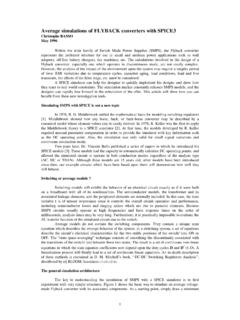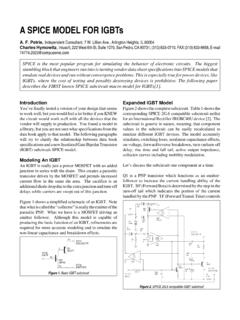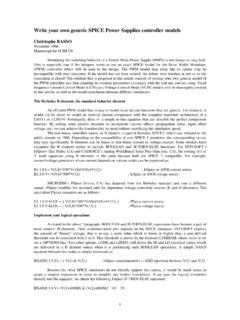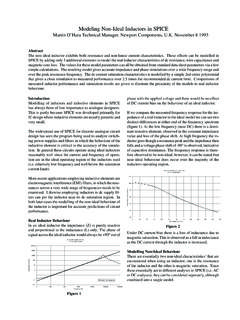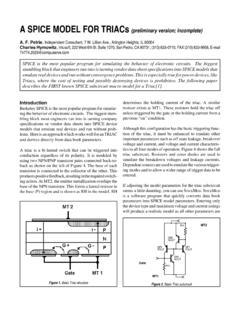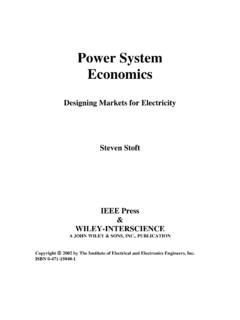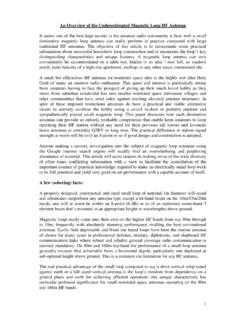Transcription of Solving Convergence Problems - Intusoft
1 355 APPENDICESS olving SPICE Convergence ProblemsKey SourcesThe following techniques on Solving Convergence Problems aretaken from various sources including:[1]Meares, , Hymowitz SIMULATING WITHSPICE , Intusoft , 1988[2]Muller, A SPICE COOKBOOK , Intusoft , 1990[3]Meares, , Hymowitz SPICE APPLICATIONSHANDBOOK , Intusoft , 1990[4] Intusoft Newsletters, various dates from 1986 topresent[5]The Designer's Guide to SPIC and Spectre, KennethS. Kundert, Kluwer Academic Publishers, 1995[6]The SPICE Book, Andrei Vladimirescu, John Wiley &Sons Inc,, 1994[7]Inside SPICE, Ron Kielkowski, McGraw-Hill, is Convergence ?
2 (or in my case, Non- Convergence )The answer to a nonlinear problem , such as those in the SPICEDC and Transient analyses, is found via an iterative example, ISSPICE makes an initial guess at the circuit s nodevoltages and then, using the circuit conductances, calculatesthe mesh currents. The currents are then used to recalculatethe node voltages, and the cycle begins again. This continues356until all of the node voltages settle to values which are withinspecific tolerance limits. These limits can be altered usingvarious .Options parameters such as Reltol, Vntol, and the node voltages do not settle down within a certain numberof iterations, the DC analysis will issue an error message suchas No Convergence in DC analysis , Singular Matrix , or Gmin/Source Stepping Failed.
3 SPICE will then terminate therun because both the AC and transient analyses require aninitial stable operating point in order to proceed. During thetransient analysis, this iterative process is repeated for eachindividual time step. If the node voltages do not settle down, thetime step is reduced and SPICE tries again to determine thenode voltages. If the time step is reduced beyond a specificfraction of the total analysis time, the transient analysis willissue the error message, Time step too small, and theanalysis will be come in all shapes, sizes, and disguises, but conver-gence Problems are usually related to one of the following: Circuit Topology Device Modeling Simulator SetupThe DC analysis may fail to converge because of incorrectinitial voltage estimates, model discontinuities, unstable/bistableoperation, or unrealistic circuit impedances.
4 Transient analysisfailures are usually due to model discontinuities or unrealisticcircuit, source, or parasitic modeling. In general, you will haveproblems if the impedances, or impedance changes, do notremain reasonable. Convergence Problems will result if theimpedances in your circuit are too high or too various solutions to Convergence Problems fall under oneof two types. Some are simply band-aids which merely attemptto fix the symptom by adjusting the simulator options. Othersolutions actually affect the true cause of the IS Convergence ?357 APPENDICESThe following techniques can be used to solve 90 to 95% of allconvergence Problems .
5 When a Convergence problem isencountered, you should start at solution 0 and proceed withthe subsequent suggestions until Convergence is sequence of the suggestions is structured so that they canbe incrementally added to the simulation. The sequence is alsodefined so that the initial suggestions will be of the most that suggestions which involve simulation options maysimply mask the underlying circuit instabilities. Invariably, youwill find that once the circuit is properly modeled, many of the options fixes will no longer be required!General DiscussionMany power electronics Convergence Problems can be solvedwith two option parameters, Gmin and Rshunt.
6 The Gmin optionis available in all SPICE 2 and 3 programs. Gmin is the minimumconductance across all semiconductor junctions. The conduc-tance is used to keep the matrix well conditioned. Its defaultvalue is 1E-12mhos. Setting Gmin to a value between 1n and10n will often solve Convergence Problems . Setting Gmin to avalue which is greater than 10n may cause Rshunt option causes ISSPICE to insert a resistor from everynode in the circuit to ground. Rshunt is available only inprograms such as ISSPICE that have incorporated the XSPICE enhancements [36]. Setting Rshunt to a value between 100 MEGand 1G will typically help.
7 Setting Rshunt to a value of 100 Kmay cause Convergence does not always converge when relaxed tolerances areused. One of the most common Problems is the incorrect useof the .Options parameters. For example, setting the toleranceoption, Reltol, to a value which is greater than .01 will oftencause Convergence default numerical integration method is the Trapezoidalmethod. Some circuits will converge better during the transient358analysis when the Gear integration method is used. You caninvoke Gear integration by adding the statement, .OPTIONSMETHOD=GEAR. The Gear method works well for most powerelectronics the value of Abstol to 1u will help in the case of circuitsthat have currents which are larger than several amps.
8 Again,do not overdo this option. Setting Abstol to a value which isgreater than 1u will cause more Convergence Problems than itwill you ve performed a number of simulations, you willdiscover the options which work best for your circuits. You cansave the .Options line in a text file and use the .INC filename command to read the text file. This will allow you to save lines in text files and explore the use of different setsof all else fails, you can almost always get a circuit to simulatein a transient simulation if you begin with a zero voltage/zerocurrent state. This makes sense if you consider the fact that thesimulation always starts with the assumption that all voltagesand currents are zero.
9 The simulator can almost always trackthe nodes from a zero condition. Running the simulation willoften help uncover the cause of the Convergence above recommendation is only true if your circuit is con-structed properly and the netlist is syntactically correct. Most ofthe time, minor mistakes are the cause of Convergence prob-lems. Error messages will help you track down the Problems ,however, a good technique is to scan each line of the netlist andlook for anomalies. It may be tedious, but it s a proven way toweed out all Convergence failures are a result of the SPICE software!
10 Convergence failures may identify many circuitproblems. Check your circuits carefully, and don t be tooquick to blame the IS Convergence ?359 APPENDICESIf you ve tried everything you can think of, and you still can t getyour circuit to converge, you may contact Intusoft s TechnicalSupport staff at We can also be reached onthe Internet at - New Convergence AlgorithmsIn addition to automatically invoking the traditional sourcestepping algorithm, ISSPICE contains a superior algorithm called Gmin Stepping . This algorithm uses a constant minimaljunction conductance which keeps the sparse matrix wellconditioned, and a separate variable conductance to ground ateach node, which serves as a DC Convergence aid.
